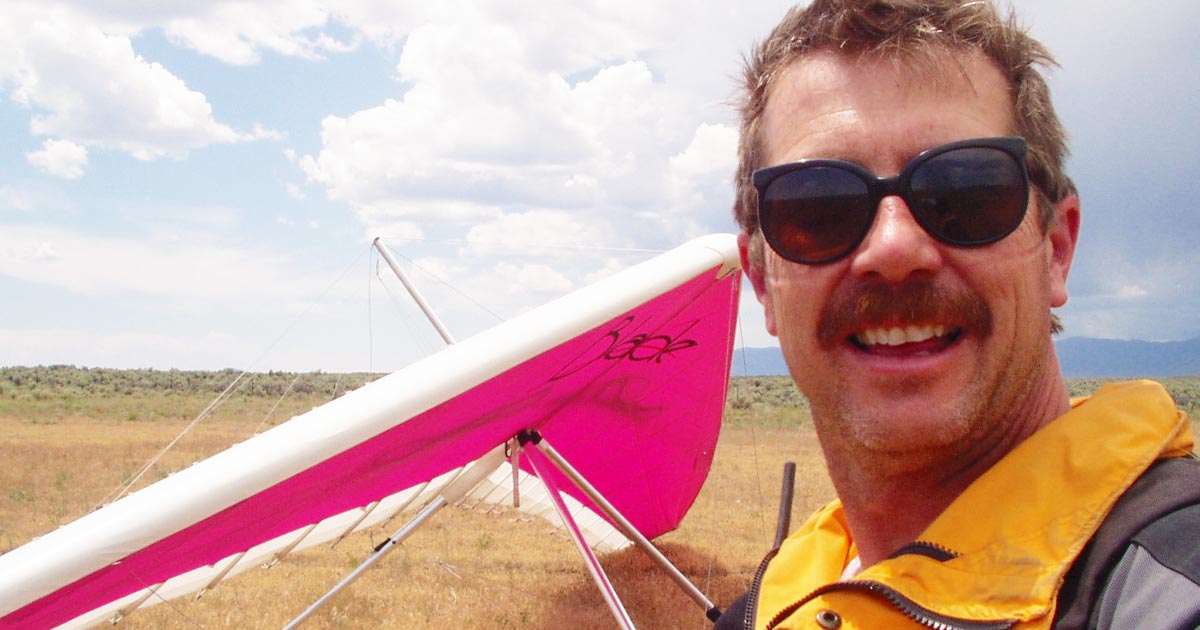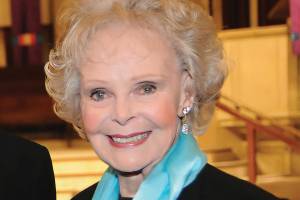By DIANNA TROYER
Since childhood, sky surfing guru John Kangas has been enraptured with flight. “I was always making gliders and wondering what it would feel like to fly.” When he was 17, he found out when he bought a hang glider.
“Back then in 1976, hang gliding was a big deal, an emerging sport,” said Kangas, who was born in Cascade, north of Boise. “We called it sky surfing. The glider came with three free lessons, launching from a place near Eagle, west of Boise. I was hooked.”
The thrill of flying has never waned for the 63-year-old pilot. He still goes on countless aerial adventures in central Idaho’s Lost River Valley, launching from King Mountain near Moore where he built a glider park.
During the flying season from April to November, he navigates powerful air currents in a sailplane (also called a glider), paraglider, or hang glider.
Paragliders are canopies with a harness attached for the pilot to sit on. A hang glider has a rigid frame and triangular shaped wing and harness for the pilot to lie prone.
“I still have the time of my life whenever I’m in the air,” said Kangas, who finds flying to be extraordinary with every launch. “I’m a tiny speck in such a big, big world. Seeing the world from the air is unbelievable. I’m living my dream.”
Kangas said his first hang glider launched his aviation career. He earned an aviation management degree from Boise State University and coached the university’s flying team. He also became a pilot, flying jets for commercial airlines and small planes in the backcountry to earn an income. He soared with hang gliders, paragliders, and sailplanes as a hobby.
Eventually Kangas heard of King Mountain, a premier launch site in the Lost River Valley. State and national paragliding and hang gliding championships were scheduled there, attracting pilots from around the world. They routinely flew 100 miles, navigating powerful thermals that flow through the valley where mountains rise to 12,000 feet.
To provide an opportunity for pilots to live their dreams, Kangas recently established a nonprofit, the King Mountain Glider Park Foundation. He wants to ensure the airfield he built is available for free in perpetuity to all types of gliders.
“I’m excited to have a dedicated volunteer board of directors from throughout the West who will make sure flying will continue to happen here,” Kangas said.
He and his wife, Rae, began building the park in 2006 after buying land about 2 miles northeast of Moore. They envisioned a place where pilots could build hangars and homes. It took three years to develop a 17-acre airfield with a 3,900-by-120-foot irrigated grass runway.
With the runway in place, they launched a Facebook page and website for King Mountain Glider Park. Kangas provided maps and detailed advice about navigating the valley’s roller coaster air currents.
“Your flying skills will definitely be tested,” he wrote on the website. “There are booming thermals, outrageous turbulence, and the promise of long cross country flights. It’s superb flying in some of the most scenic mountains in the world.”
To share their love of King Mountain, John and Rae in 2009 began hosting an informal annual summer fly-in, the King Mountain Safari for “all birds”” — paragliders, hang gliders, and sailplanes. More than 60 pilots from throughout the West usually came.
Their last Safari was in 2018, due to Rae’s deteriorating health. Kangas became her caretaker until she passed away last year.
“Rae loved King Mountain as much as I did,” Kangas said. “She grew up next to an airport and loved small planes and gliders. When I’m working at the park, I’m still missing my beautiful wife, but an old fighter pilot friend told me, ‘Press On.’ She would want to see our vision completed.”
Last fall, Kangas installed a pump and finished the irrigation system.
“I’m looking forward to making it operational this spring,” he said.
Whenever he soars, Kangas recalls a pioneering pilot, Frank Gillette, who helped establish the launch site at King Mountain in the early 1970s. At that time, Frank and a few other pilots were taking off from the Big Southern Butte about 50 miles south of King Mountain.
Catching a thermal one day, Frank happened to fly his hang glider to the mountain, where he noticed a road leading to an ideal launch site.
“Frank was the flying icon to aspire to, the hero of our flying,” Kangas said. “I was fortunate to fly with him.”
In 1993, Frank, 63 at the time, set an Idaho distance record for hang gliding. He flew 162 miles from King Mountain to Anaconda, Montana. His record was broken in 2000 with a 180-mile flight to Bozeman, Montana.
Kangas’s personal Idaho distance record is 100 miles. In three hours, with a powerful tailwind, he soared from King Mountain to just west of Henry’s Lake and landed in the Centennial Valley.
“To fly with no engine, to sustain your flight based on your feel, your knowledge of the sky, what you observe, what you’ve learned before, and being able to apply it and continue to grow is a dream come true for people who have a passion for flying,” Kangas said. “If you experience it, you never ever forget. We’re doing what man has dreamed of doing for thousands of years. It touches your soul.”
With airfield upgrades completed, Kangas is considering hosting a fly-in in September, depending on air quality. In the past, events were sometimes canceled because smoke from wildfires caused poor visibility.
“Whatever happens, King Mountain is still Idaho soaring at its best,” Kangas said. “All birds are always welcome here.”
Kangas’s aerial adventures and advice about flying in the valley may be found at kingmountaingliderpark.com.
Sky Surfing Lures Pilots to Mount Sentinel
Pilots succumb to the siren’s song of flight not only at King Mountain but also at Mount Sentinel, southeast of Missoula. Mount Sentinel has the distinction of being the oldest registered inland hang gliding site in the United States.
Lisa Tate and Karl Hallman, hang glider pilots and Missoula residents, have flown at both places, soaring over central Idaho for hours, setting personal records.
Hallman flew 110 miles from King Mountain to beyond Salmon, Idaho. Tate had her greatest altitude gain at King Mountain, reaching close to 17,000 feet.
“You share thermals with birds,” said Hallman, 58, a respiratory therapist at Providence St. Patrick Hospital in Missoula. “It’s wonderful up there.”
Tate, 57, is the executive director of the National Museum of Forest Service History. She’s been fascinated with flight since childhood. “I was always making airplane models. As an adult, hang gliding was my life.”
Tate’s connection to King Mountain endured for more than two decades. She organized annual fly-ins and world-class competitions. She also served as president of the United States Hang Gliding and Paragliding Association.
“Due to geography and weather conditions, King Mountain is a world-class destination for pilots who need dynamic, powerful thermals for long, cross-country flights,” Tate said. “Mount Sentinel is known for weather patterns that provide smooth, buoyant flights.”
Hang glider and paraglider pilots at both mountains are known for their camaraderie.
“At King Mountain, I made lifelong friends,” Tate said. “Flying there was the highlight of summer for me and other pilots. The hang gliding community in Missoula is wonderful, too.”
Tate flew for several years at King Mountain competitions. With her organizational skills, she was eventually asked to manage annual summer events there.
“I wanted to participate rather than organize, but if no one else was going to, I didn’t want to see them canceled, so I agreed to plan events that would draw pilots together and keep our sport alive,” Tate said.
Although she has not flown for several years due to work commitments, Tate said hang gliding guided her life since she was 12, when she saw pilots soaring from Mount Sentinel where she grew up.
“One day, I was riding a horse near there and felt compelled to look up. I hadn’t seen a shadow or heard anything. I just sensed something above me. A hang glider pilot was about 50 feet over me and waved. It blew my mind and was the coolest thing,” said Tate. “At that moment, I knew I’d fly a hang glider one day.”
To learn more about hang gliding, Tate volunteered to shuttle vehicles for Missoula pilots. She eventually moved to Boise, Idaho, to take lessons, fly year-round with the mild winters, and become a proficient pilot.
“I flew as often as I could when I had free time from working as a museum consultant and a glass artist,” she said.
Hallman became addicted to hang gliding in 1987 when he dropped by a friend’s house.
“He had just flown his hang glider over the Mission Mountains,” Hallman said. “It was an amazing thing to do, so the next day I bought a hang glider and learned to fly. I love flying as far as I can.”
His goal is to surpass the distance flown by his mentor, Peter Swanson.
“He holds the record of flying to Helena,” Hallman said. “It’s a record that stands to this day no matter how hard I and bunch of very good cross-country pilots have tried to better it. There are so many memories from decades of flying, and there’s always time to make more.”
To learn more about gliding around the Missoula area, see glidemissoula.org MSN








